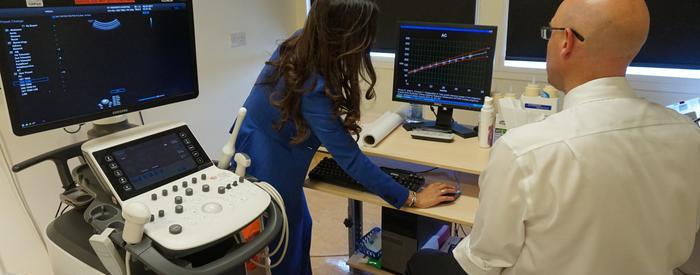This was our first foray into clinical research, carried out by St George’s Hospital in London, to develop the world’s first twin pregnancy growth charts.
With your help we raised the money needed to fund the research and ultimately create the charts which are FREE to download and use by any NHS Trust.
Twin babies have always been measured during pregnancy using singleton growth charts and clinicians must use their judgement to decide how the pregnancy is progressing.
The twin pregnancy growth charts have been specially designed with twins in mind, so doctors and medical professionals who scan pregnant women expecting twins can use them to accurately measure the babies’ growth.

These charts make it easier to identify twins who have genuine growth restriction and who are therefore at risk of stillbirth and may need intervention to keep them safe.
They will also prevent the false diagnosis (thinking that the babies are growth restricted but they are not) therefore potentially avoiding unnecessary intervention in the form of premature delivery.
The twin specific growth charts are available online for use by all units. Please speak to your healthcare professional if you’re unsure which growth charts your maternity unit are using.
Further research
The Twins Trust Centre for Research and Clinical Excellence has carried out further research to evaluate how use of the twin charts can help identify babies who are at risk of needing intervention due to their size.
The Association Between Hypertension in Pregnancy and Preterm Birth with Fetal Growth Restriction in Singleton and Twin Pregnancy: Use of Twin Versus Singleton Charts
This study was a comparison of singleton and twin pregnancy growth charts, to see how accurately they can assess growth in twin pregnancies, by looking at pregnancies with growth restriction. The twin charts showed a link between growth restriction, and hypertensive (high blood pressure) disorders¯and ¯preterm birth, whereas the singleton charts did not show this link. This tells us that the twin charts more accurately identify the pregnancies with growth problems may need intervention, compared with the singleton charts which may over-diagnose growth problems in pregnancies which don’t need any intervention.
This study shows that the use of the twin-specific charts is likely to be more informative and more clinically useful in identifying twins who are truly suffering from growth restriction. Their use is likely to reduce prematurity as a result of unnecessary medical intervention.
Perinatal Outcomes of Small for Gestational Age in Twin Pregnancies: Twin vs. Singleton Charts
Twin growth is often assessed using singleton charts, leading to an overdiagnosis of babies who are deemed small for gestational age, which can lead to unnecessary intervention and early delivery. This study looked at the outcomes of 1740 twin pregnancies to see if twin charts were more effective at identifying twin pregnancies which were truly small and needing intervention. Twin charts identified fewer of the pregnancies as small for gestational age compared to singleton charts, but a higher proportion of those identified experienced neonatal complications. Babies identified as small by the twin charts were also more likely to have abnormal Doppler readings than babies identified as small by the singleton charts. This suggests that the twin charts may be better at identifying babies who are truly small and in need of treatment.
Are Twin Pregnancies Complicated by Weight Discordance or Fetal Growth Restriction at Higher Risk of Preeclampsia?
This study examined the potential link between hypertensiveâ¯(high blood pressure)â¯disorders, such as pre-eclampsia, and growth restriction in twin pregnancy. The study concluded that there is a significant association between growth restriction and hypertension.â¯This means that aâ¯pregnancy with at least one twin measuring small (compared to expected size for the number of weeks of pregnancy) isâ¯likely to experience hypertensive conditions likeâ¯pre-eclampsia. For this reason, the study recommends that mothers’ blood pressure should be closely monitored if at least one baby is found to be small.â¯
*The results of the research were published of data in the Ultrasound in Obstetrics and Gynaecology journal in August 2014.
-strap.svg)
